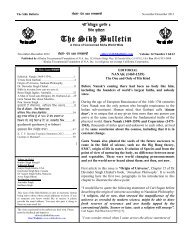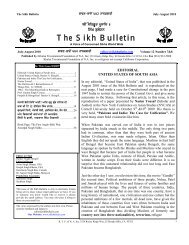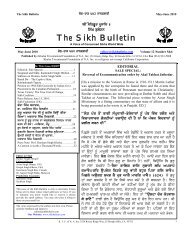Selected Editorials - The Sikh Bulletin
Selected Editorials - The Sikh Bulletin
Selected Editorials - The Sikh Bulletin
Create successful ePaper yourself
Turn your PDF publications into a flip-book with our unique Google optimized e-Paper software.
eyku ipqw eyks ky hm bwirk qU myrw gur hweI ]<br />
GGS P 611<br />
nw kY bYrI nhI ibgwnw sgl sMig hm kau bin AweI ] GGS P. 1299<br />
It is ok to take these words of Gurbani literally, sometimes.<br />
Hardev Singh Shergill<br />
*****<br />
EDITORIAL<br />
[From May-June 2013 issue of <strong>The</strong> <strong>Sikh</strong> <strong>Bulletin</strong>]<br />
SAT KARTAR<br />
At the Singh Sabha International Canada conference in Brampton in September 2012, when the<br />
Constitution and By-Laws were being voted upon, only four of us among about sixty participants, voted<br />
against the requirement that all members of the Executive Committee be kesadhari.<br />
In an earlier editorial I have expressed my views that on one hand we make a case, and rightly so, that in<br />
matters of religious scriptures there is nothing like the Guru Granth Sahib. All other scriptures were<br />
written by many authors and that too after the founders’ passing. Guru Granth Sahib not only has the<br />
original scriptures by Guru Nanak and some of his successor Gurus but also the writings of Hindu and<br />
Muslim writers, who were not kesadhari. Guru Nanak’s lifelong companion, a Muslim, Mardana, was<br />
also most likely a non-kesadhari, as his descendants are today.<br />
We can truly describe GGS as a universal message. But over time the outward appearance for a <strong>Sikh</strong> has<br />
gained precedence. Hair has become so sacred that the SGPC went to court to get the definition of a <strong>Sikh</strong><br />
as Kesadhari to deny admission to one of its Medical Colleges to a <strong>Sikh</strong> daughter who plucked her<br />
eyebrows and succeeded. SGPC should really have gone to Guru Granth Sahib instead.<br />
Upon reflection, though, the decision of that conference made sense. It reminded me of Mr. Tohra’s<br />
response when asked why women were not allowed to participate in sewa at Darbar Sahib. His prompt<br />
and honest answer was that it has become ‘maryada’ (tradition) now. He did not have a moment’s<br />
hesitation in giving that response even though he must have known that the person whose institutions he<br />
was managing broke most of the ‘maryadas’ of the religion and the society that he was born into.<br />
That event in that conference did put me on a course of serious thinking. <strong>The</strong> idea of Singh Sabha<br />
International had germinated at Roseville, California in December 2000. <strong>The</strong>re it died but in Ontario,<br />
Canada it is doing a positive job of funding missionary graduates of the Missionary College in Ludhiana<br />
and preparing CD’s on gurbani and other religious literature for mass distribution. <strong>The</strong>ir work is confined<br />
primarily to Punjab and few other parts of India. Any attempt on their part to negate the significance of<br />
uncut hair would impede their effort back ‘home’.<br />
In another editorial I have stated that I became a confirmed agnostic at the age of twelve after reading<br />
‘Bachittar Natak’ and ‘Bale-dian-Sakhian’ to practice reading and writing Panjabi at home and reading<br />
‘Mahabharat’ and ‘Ramayan’ from the middle school library. Being born into a <strong>Sikh</strong> household I had<br />
uncut hair when I arrived in this country in 1960 at the age of twenty-six but within four months I was<br />
clean shaven.<br />
That lasted until 1997 when Bhai Jeewan Singh and Ripudaman Singh Malik of Satnam Education<br />
Society of British Columbia, Canada came to the Roseville, California Gurdwara to hold summer gurmat<br />
81
















